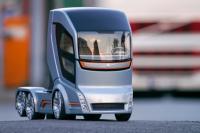Volvo Concept Truck 2020

Progress is getting ever faster. In just ten years’ time trucks are going to be a lot different to those of today. At least according to Rikard Orell, Design Director at Volvo Truck Corporation and one of the brains behind Concept Truck 2020, the Volvo Truck Corporation's bold vision for the future.
Long distance haulage for the future: long rigs, controlled by autopilot, driven non-stop in nose-to-tail convoys on green super-motorways linking the continents. This is the vision of the future that generated the ideas behind the Volvo Concept Truck 2020 design concept. But will it really look like this in just ten years? "That is the whole point," says Rikard Orell Design Director at Volvo Trucks. "Progress is getting ever faster. Because of this our vision for the future is not that far away. Much of the technology in the Volvo Concept Truck 2020 is already available, other technology needs to be developed."
As road transport expands it must also become safer and more efficient. Volvo's design concept contains ideas about how that can be achieved. One of the more startling ideas is to link vehicles together wirelessly into long trains that rush across the continents at 90 km/h. "This will be possible when the transport sector's vision of green corridors becomes reality," says Rikard Orell. "Here heavy goods vehicles are separated from other traffic, driving in their own lanes, like a railway but without rails." The design concept from Volvo Trucks contains a great many ideas about the development of the driver environment. In the Volvo Concept Truck 2020 the driver environment is spacious, airy and free of disruption. "We have replaced the traditional dashboard with a thin film panel on which information is tailored to suit the driver," says Rikard Orell. "The panel is operated like a touchpad, just like an iPhone. We have saved a lot of space that way." Another space-saving idea is the sleek driver's seat with its thin, ventilated mesh backrest, more like a modern office chair than a traditional driver's seat. Behind the driver is a futon sofa which folds out into a wide, comfortable bed in the evening. The lighting in the cab is divided into zones customised for the driver's various in-cab tasks, or for resting.
The design team also aimed for a sleek look for the exterior, reducing the perception of the vehicle's size. The LED headlamps and turn indicators are integrated into the front of the vehicle. The rear-view mirrors have been replaced by cameras that project their images onto the inside of the windscreen. The lower section of the front of the vehicle features integrated collision protection projecting forwards about half a metre. This "nose" is gentler on oncoming cars in the event of a head-on collision, and has also been shown to improve aerodynamics. Some things you just do not change. The Globetrotter sign on the roof is still there, but has been redesigned so that it harmonises with the lines of the vehicle and reduces drag. The driver can change the text on the sign from the instrument panel.


